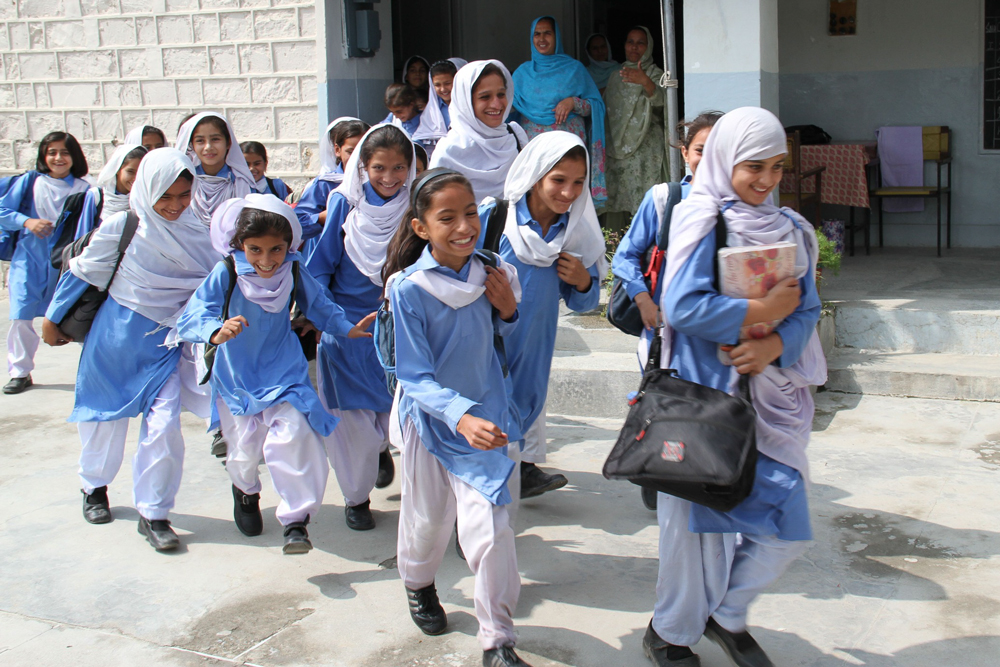
A brief monthly phone call to school council members in Pakistan can be a relatively low-cost, scalable way to raise elementary-school enrollment – particularly for girls – and spur school improvement, according to a new study co-authored by Stanford Graduate School of Education Professor Thomas Dee and alumna Minahil Asim.
In the study, Asim and Dee evaluated the impact of the School Council Mobilization Program, a pilot initiative that took advantage of the widespread ownership of cell phones in rural Pakistan to strengthen citizen oversight of local schools.
"The program cost about $50 per school and it increased enrollment by roughly 12 students in the typical primary school for girls," Dee said. "The fact that one could drive improvement in such an important outcome at low cost is extraordinarily exciting to me," added Dee who is also a senior fellow at Stanford Institute for Economic Policy Research.
The researchers, who were not involved with the mobilization program and received no outside funding for their study, were impressed by the design of the intervention and decided to examine whether it had any effect.
The school councils were established in the mid-1990s to strengthen school governance. People are often more motivated to improve their local services than central government bureaucrats. But, the performance of the councils had been mixed and it was unclear whether council members were fully aware of their roles.
The councils were made up of a head teacher and prominent individuals in the community – including shopkeepers, clerics and parents – who served for a year. A prior effort to inform council members about their responsibilities through a three-day in-person training that cost about $180 per school had been ineffective.
Simple and low-cost
In contrast, the School Council Mobilization Program used phone calls to provide a targeted, sustained, one-to-one engagement mechanism between the provincial government and school councils. Moreover, it was relatively low-cost and had the potential of being expanded to a larger scale.
The initiative, which was funded by the World Bank, paid a call center to place monthly calls for 17 months to school council members at larger schools in five districts of the Punjab province. On each call, which lasted about six minutes, the same calling agent would inform a member of a specific responsibility such as monitoring attendance, increasing enrollment and school planning. Text messages were also used initially, but were discontinued because many council members were unable to read.
In order to determine whether the call strategy had an impact, Asim and Dee looked at school outcomes before and after the intervention took place. They used comparisons with other schools and with districts where the program was not piloted to distinguish the effects of the intervention from those of other reforms and trends taking place.
They found that, in addition to raising student enrollment by 5.7 percent at the elementary-school level, the program increased teacher attendance by roughly 2 percent and made it more likely that schools had functional facilities such as toilets and water.
Gender disparities
Boys and girls in the region attend separate schools and the impact of the program varied greatly depending on the characteristics of the schools. The increase in student enrollment at boys' elementary schools was much smaller, 4.6 percent, compared with the 12.4 percent increase at girls' schools. However, the program was also associated with a small drop in school attendance by girls. It is possible that newly enrolled girls had more absences, which underscores the challenge of promoting sustained school engagement among young girls in the region.
Similarly, while girls' schools only saw increased availability of water (which could be as simple as having containers with water at school), the program improved additional facilities such as toilets and boundary walls at boys' schools. The researchers speculate that there might have been more cultural comfort with men negotiating to improve school facilities at boys' schools, because school councils tend to be composed of members of the same gender as the students.
The initiative had no discernible impact on middle schools. "It may be that an emphasis on the Millennium Development Goal of achieving universal primary-school enrollment gave particular force to the mobilization initiatives at the primary schools," Dee said.
The impact of the program grew as the intervention progressed and the effects persisted a few months after it ended. But whether effects remain in the longer term –and whether the intervention can work at a larger scale – remain open questions.
Ultimately, the instructional quality and learning opportunities available for the students at the schools will play a key role in the long-term success of the efforts. "It is important to get kids in school, to get teachers to show up, and for schools to have good facilities," Dee said. "Those are necessary conditions for kids to unlock their educational potential – but they are not sufficient conditions. We also need to address the quality of the learning opportunities that are available in these schools."
Minahil Asim earned her master's degree in International Comparative Education at Stanford Graduate School of Education and is currently pursuing a doctorate in Education Policy at the University of California, Davis.
The paper, Mobile Phones, Civic Engagement, and School Performance in Pakistan, was released as an NBER working paper. It is also posted on the website of the Stanford Center for Education Policy Analysis, which Dee directs.
Subscribe to our monthly newsletter.